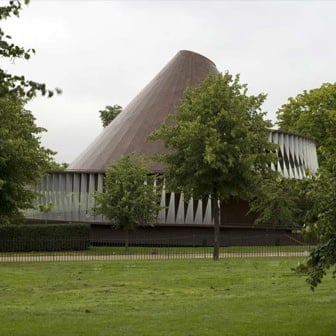Photographer Luke Hayes has sent us what we believe is the first comprehensive set of professional photos showing both the interior and exterior of the just-completed Serpentine Gallery Pavilion 2007. Update: this project is included in Dezeen Book of Ideas, which is on sale now for £12.
Designed by artist Olafur Eliasson and architect Kjetil Thorsen of Snøhetta, the pavilion opens at the Serpentine Gallery in Kensington Gardens, London, tomorrow (Friday 24 August).
More on the background to this story here.
All photos are © Luke Hayes and used with his permission.
Here is some press info from the Serpentine Gallery including a statement from the designers:
--
Serpentine Gallery Pavilion 2007: Designed by Olafur Eliasson and Kjetil Thorsen
The Serpentine Gallery Pavilion 2007, designed by the internationally acclaimed artist Olafur Eliasson and the award-winning Norwegian architect Kjetil Thorsen, of the architectural practice Snøhetta, will open on 24 August and remain on site until 11 November 2007.
The Serpentine Pavilion 2007 is a spectacular and dynamic building. The timber-clad structure resembles a spinning top and brings a dramatic vertical dimension to the more usual single-level pavilion. A wide spiralling ramp makes two complete turns, ascending from the Gallery’s lawn to the seating area and continuing upwards, culminating at the highest point in a view across Kensington Gardens and down into the chamber below.
The Pavilion will act as a ‘laboratory’ every Friday night with artists, architects, academics and scientists leading a series of public experiments. The programme, conceived by Eliasson and Thorsen with the Serpentine, will begin on 31 August and culminates in two extraordinary 24-hour Serpentine Gallery Experiment Marathons, first in the Pavilion in London during Frieze Art Fair, then in Berlin in November.
The Serpentine Gallery Pavilion commission, now entering its eighth year, is an ongoing programme of temporary structures by internationally acclaimed architects and individuals. It is unique worldwide and presents the work of an international architect or design team who, at the time of the Serpentine Gallery's invitation, has not completed a building in the UK. The Pavilion architects to date are Rem Koolhaas and Cecil Balmond, with Arup, 2006; �?lvaro Siza and Eduardo Souto de Moura with Cecil Balmond, Arup, 2005; MVRDV with Arup, 2004- (un-realised); Oscar Niemeyer, 2003; Toyo Ito with Arup, 2002; Daniel Libeskind with Arup, 2001; and Zaha Hadid, 2000.
As part of the expansion of the Serpentine Gallery’s programme, the architecture strand this year also included Lilas, an installation commissioned from Zaha Hadid Architects and designed by Pritzker Prize-winning architect Zaha Hadid and Patrik Schumacher on the occasion of the Gallery’s world-renowned fundraiser, The Summer Party, which took place on 11 July.
Designers’ Statement
Based on the principle of a winding ramp, the 2007 Serpentine Gallery Pavilion explores the idea of vertical circulation within a single space. The aim is to reconsider the traditional, single-level pavilion structure by adding a third dimension: height. The vertical movement of visitors in the Pavilion will complement the horizontal circulation in the exhibition spaces at the adjacent Serpentine Gallery.
Visitors are invited to ascend from the lawn to the roof via the ramp, which functions as a mediator between the Pavilion interior and its surroundings. Whilst journeying upwards, they will first encounter the interior space, which is followed by an enclosed stretch of the ramp with the surroundings only glimpsed through the louvered facade.
As they proceed, visitors will complete the spiralling movement, the ramp becomes integrated into the roof of the Pavilion, and they experience a full, unhindered view of the park.
The interior will be lit by daylight, emitted through the oculus in the roof. The space itself is defined by a geometric pattern that is both articulated as the wall surface and as places in which one can sit. The movement and interaction of the visitors will thus be a defining component of the Pavilion.
Olafur Eliasson and Kjetil Thorsen, 2007

